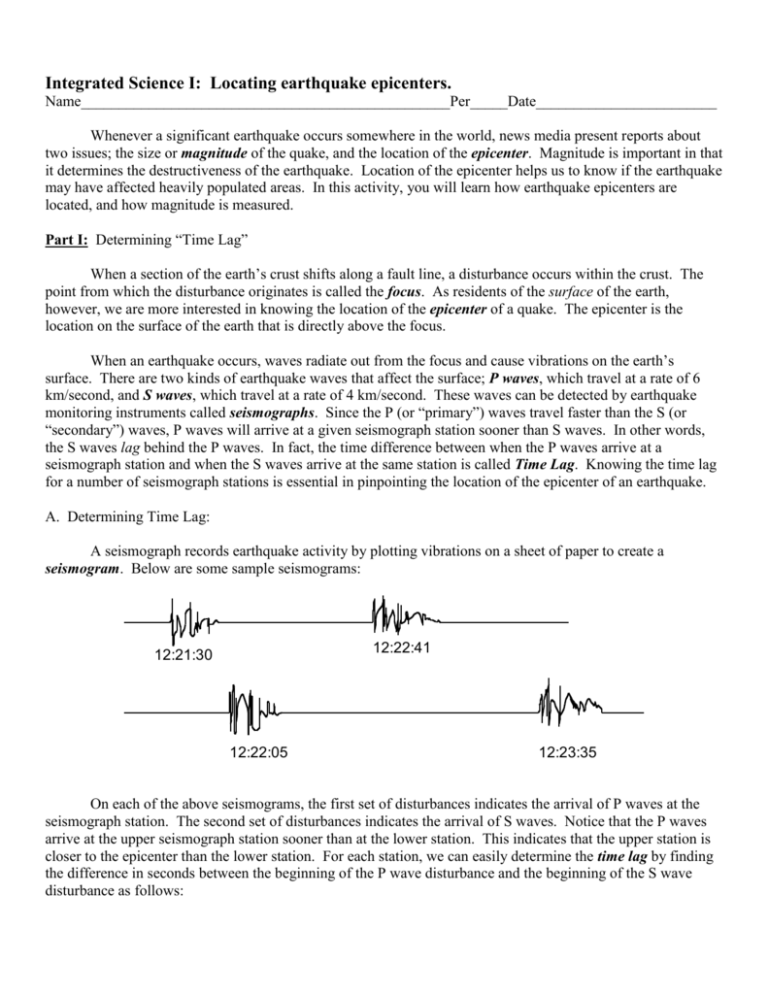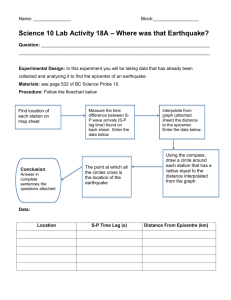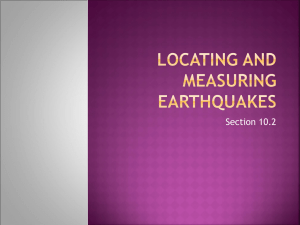Integrated Science I: Locating earthquake epicenters
advertisement

Integrated Science I: Locating earthquake epicenters. Name_________________________________________________Per_____Date________________________ Whenever a significant earthquake occurs somewhere in the world, news media present reports about two issues; the size or magnitude of the quake, and the location of the epicenter. Magnitude is important in that it determines the destructiveness of the earthquake. Location of the epicenter helps us to know if the earthquake may have affected heavily populated areas. In this activity, you will learn how earthquake epicenters are located, and how magnitude is measured. Part I: Determining “Time Lag” When a section of the earth’s crust shifts along a fault line, a disturbance occurs within the crust. The point from which the disturbance originates is called the focus. As residents of the surface of the earth, however, we are more interested in knowing the location of the epicenter of a quake. The epicenter is the location on the surface of the earth that is directly above the focus. When an earthquake occurs, waves radiate out from the focus and cause vibrations on the earth’s surface. There are two kinds of earthquake waves that affect the surface; P waves, which travel at a rate of 6 km/second, and S waves, which travel at a rate of 4 km/second. These waves can be detected by earthquake monitoring instruments called seismographs. Since the P (or “primary”) waves travel faster than the S (or “secondary”) waves, P waves will arrive at a given seismograph station sooner than S waves. In other words, the S waves lag behind the P waves. In fact, the time difference between when the P waves arrive at a seismograph station and when the S waves arrive at the same station is called Time Lag. Knowing the time lag for a number of seismograph stations is essential in pinpointing the location of the epicenter of an earthquake. A. Determining Time Lag: A seismograph records earthquake activity by plotting vibrations on a sheet of paper to create a seismogram. Below are some sample seismograms: 12:22:41 12:21:30 12:22:05 12:23:35 On each of the above seismograms, the first set of disturbances indicates the arrival of P waves at the seismograph station. The second set of disturbances indicates the arrival of S waves. Notice that the P waves arrive at the upper seismograph station sooner than at the lower station. This indicates that the upper station is closer to the epicenter than the lower station. For each station, we can easily determine the time lag by finding the difference in seconds between the beginning of the P wave disturbance and the beginning of the S wave disturbance as follows: Upper station: P wave arrival time = 12:21:30 S wave arrival time = 12:22:41 Time lag = 1 minute, 11 seconds, or 71 seconds Lower station: P wave arrival time = 12:22:05 S wave arrival time = 12:23:35 Time lag = 1 minutes, 30 seconds, or 90 seconds Once we have determined the time lag for a particular seismograph station, we can then determine its distance from the earthquake epicenter by the following formula: Time Lag (sec.) x 60 km 5 sec. Using this formula, see if you can determine the distance of the two seismograph stations from the earthquake epicenter. Upper station: Distance = ____________ Lower station: Distance = ____________ QUESTIONS: 1. Please describe the relationship between time lag and distance from the epicenter. Use data from this sheet to substantiate your answer. 2. Please describe the relationship between distance from the epicenter and P wave arrival time. Use data from this sheet to substantiate your answer. Part II: Locating the epicenter by “Triangulation” Suppose a single seismograph station showed a time lag of 100 seconds for a particular earthquake. Using the math formula above, we can easily determine that this seismograph station is a distance of 1200 km from the epicenter. Does this tell us exactly where the earthquake epicenter was located? No! All we know at this point is that the epicenter is located somewhere along a circle of points exactly 1200 km from the single seismograph station. To accurately pinpoint the location of an earthquake epicenter, we need seismograph data from a minimum of three locations. Using data from three seismograph stations to locate an earthquake epicenter is a process known as triangulation. The following exercise will give you an opportunity to practice the process of triangulation to locate some earthquake epicenters. A. Below are seismograph readings for two separate earthquakes. For each seismograph reading, determine the time lag. Quake #1. Station Helena 1:31:20 1:32:43 Denver 12:32:00 12:34:22 San Francisco 12:30:47 12:31:58 Please determine time lags (in seconds) and distances for each station Helena: Denver: San Francisco: Time lag = _____________ Time lag = _____________ Time lag = _____________ Distance = _____________ Distance = _____________ Distance = _____________ Quake #2 Station Boise 1:05:00 1:06:07 Austin 1:06:15 1:08:10 Seattle 1:05:25 1:06:57 Please determine time lags (in seconds) and distances for each station Boise: Austin: Seattle: Time lag = _____________ Time lag = _____________ Time lag = _____________ Distance = _____________ Distance = _____________ Distance = _____________ Integrated Physical Science: Locating Earthquake Epicenters Name______________________________________________ Date_____________________________ Below is a map depicting the Pacific Coast and Rocky Mountain States. The map scale is 1cm:120km Se Po Bi Bo Sl Ch Re Sf De Lv La Ph Sd Se = Seattle, Washington Po = Portland, Oregon Bo = Boise, Idaho Bi = Billings, Montana Re = Reno, Nevada Sl = Salt Lake City, Utah Ch = Cheyenne, Wyoming Sf = San Francisco, California Lv = Las Vega, Nevada La = Las Angeles, California Sd = San Diego, California Ph = Phoenix, Arizona De = Denver, Colorado Al = Albuquerque, New Mexico Al Earthquake Location by Triangulation: The map on the front page of this handout will be used to locate the epicenters of five different earthquakes, using the process of triangulation. Vocabulary: Define the following terms Epicenter: Triangulation: Time Lag: Seismograph: P-waves: S-waves: Earthquake data: The following table show data for five different earthquakes Earthquake 1 Seismograph Portland, OR Boise, ID Los Angeles, CA Earthquake 2 Seismograph Seattle, WA Denver, CO Billings, MT Earthquake 3 Seismograph Albuquerque, NM Reno, NV San Diego, CA P-wave time 9:02:20 9:03:00 9:03:10 S-wave time 9:03:50 9:04:45 9:04:58 Time Lag (sec) Epicenter Distance (km) Map Distance (cm) P-wave time 9:03:10 9:04:30 9:02:15 S-wave time 9:04:58 9:06:45 9:03:57 Time Lag (sec) Epicenter Distance (km) Map Distance (cm) P-wave time 12:01:30 12:02:00 12:02:10 S-wave time 12:02:45 12:03:48 12:03:59 Time Lag (sec) Epicenter Distance (km) Map Distance (cm) Earthquake 4 Seismograph Salt Lake City, UT Cheyenne, WY San Francisco, CA Earthquake 5 Seismograph Phoenix, AZ Reno, NV Denver, CO P-wave time 1:05:00 1:05:20 1:04:30 S-wave time 1:08:00 1:09:32 1:06:33 Time Lag (sec) Epicenter Distance (km) Map Distance (cm) P-wave time 3:15:00 3:12:10 3:14:20 S-wave time 3:18:37 3:13:52 3:17:53 Time Lag (sec) Epicenter Distance (km) Map Distance (cm) a) Calculate the time lag in seconds for each of the seismograph stations in the five tables above. b) Calculate the distance from the epicenter for each seismograph station, using the math equation: distance from epicenter = time lag x 8 km/sec c) Divide the distances from the epicenter by 120 to determine the map distances. d) Using a ruler, set the distance between a compass point an a compass pencil at a distance equal to the map distance. Insert the compass point in the appropriate city on the map, and draw a circle. e) Use the triangulation method to pinpoint the epicenter of each earthquake on the map. Answer the following questions: 1. Why do you need data from three seismographs to find the epicenter of an earthquake? 2. Which of the five earthquakes would be the greatest threat to us in Vancouver? 3. Tsunami’s are large, destructive waves that occur along the coast. They are caused by earthquakes that happen underneath the ocean floor. Will any of these five earthquakes cause a Tsunami? Which one? 4. Describe the locations of the epicenters of each of the five earthquakes on this map.






